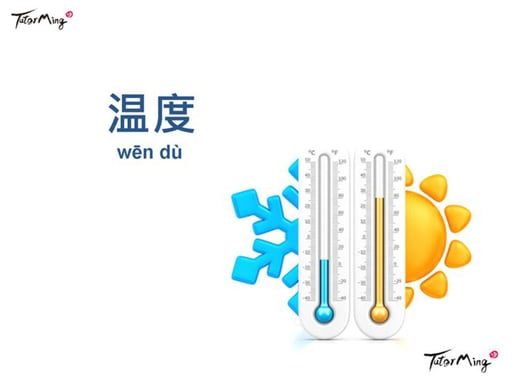My name is Efrain, and this is my weekly column on my journey to becoming fluent in Chinese with TutorABC Chinese. You can check out why I want to learn Chinese in my introduction here.
It’s almost always sunny in California where I live, so it’s typically very hot. We’re still technically in “winter” months, but the only time I need a jacket is at work. (For some reason, it’s always freezing in the office.) As we get closer to summer and the weather begins to heat up, I will need to know how to communicate temperature in Chinese. Whether (pun intended) it be to describe the general climate, or the temperature of a preferred beverage, this week’s lesson can definitely come in handy.
Related: Chinese Vocabulary Words For Summer You Should Know
As a vocabulary building lesson, it was not too difficult for me. Based on my feedback from previous sessions, the consultants gave me fewer vocabulary words this week. This was good for me because it allowed me to focus on the words from this week, and review material from previous lessons. The more opportunities I have to combine new words to old phrases, the better.
New Sentence: 今天几度?
The new sentence I learned was “今天几度(jīn tiān jǐ dù)?” I knew that “今天 (jīn tiān)” meant “today” from previous lessons. My teacher explained that this sentence meant, “How many degrees is it today?”
This confused me. I thought “How” was “怎么(zěn me),” as I learned in last week’s lesson. However, my teacher explained that “几 (jǐ)” implies “how many,” which turns the sentence into a question.
It seems that there are so many different ways to phrase a question in Chinese. I have so much more to learn!
暖和 (nuăn huo) vs 温 (wēn)

One thing I have learned from writing this blog has been to ask questions. After being introduced to 今天温度 (jīn tiān wēn dù) for “today’s temperature,” I was provided with the following responses. 热 (rè) for “hot”, 冷 (lěng) for “cold” and 暖和 (nuăn huo) for “warm.” Nothing odd. That is, until I was presented with how to describe a glass of water. I could still use 热 (rè) and 冷 (lěng), but the word for warm changed to “温 (wēn)”
Why??? (Insert frustrated cry here.)
My teacher explained that 暖和 (nuăn huo) is used for climate, describing air, or can be used for temperature one feels throughout the body.
温 (wēn) is used for food, or something you can touch and feel with a part of your body. I guessed that it has something to do with the radicals in the character itself. My teacher said that I could use the water radical to remind myself that “温” is often used to describe water temperature.
Related: The Fast Track Guide To Chinese Radicals
These types of lessons help me tremendously in my growth. Since writing and recapping my lessons, I have been going over and analyzing the information differently. Having to explain what I am being taught has added another element to learning. If you have the time, try it! Let me know how it works as it should help... to a certain “degree” (okay I’ll stop now).
Sentence Structure Review
今天几度 (jīn tiān jǐ dù)?
Translation: How many degrees is it today?
Vocabulary List
|
温度
|
wēn dù
|
Temperature
|
|
温度计
|
wēn dù jì
|
Thermometer
|
|
暖和
|
nuăn huo
|
Warm (Climate)
|
|
温
|
wēn
|
Warm (Food/Touch)
|
|
冷
|
lěng
|
Cold
|
|
热
|
rè
|
Hot
|
|
冰水
|
bīng shuǐ
|
Ice Water
|
|
热水
|
rè shuǐ
|
Hot Water
|
Like this post? Join uS to learn more!
